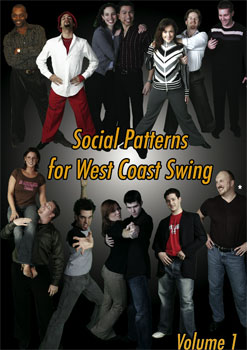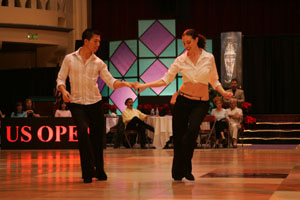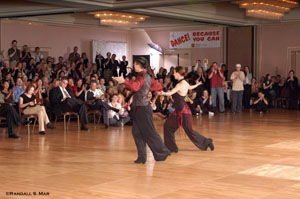EdwinLi.com > West Coast Swing
West Coast Swing: The Dance and the Dancer

Social Patterns for WCS vol 2 released in December 2006!
Under the leadership of Doug Silton, Libbat Shaham and Edwin plus 12 other Champion dancers have banded together to produce an unprecedented instructional video series, "West Coast Swing Champions", the first five two-hour DVDs of which are available now.
Over the course of eight DVDs, the series documents the diversity and versatility of our dance as never before:
Fourteen sets of teachers on the same topics--social patterns, connection, styling and footwork, and competition moves.
Fourteen perspectives from dancers of inimitable styles, Champions all.
This is a smorgasbord of material to see, hear, compare, and contrast.
Absorb what appeals to and works for you. Leave behind what doesn't.
Discover, refine, evolve, and develop your self.
To order the new "Social Patterns for West Coast Swing, volume 2" and our other DVDS or, for more info, visit our Buy Videos page.
About West Coast Swing (WCS)
|
Last updated:
Tuesday, June 18, 2013
The Most Musically Versatile Partner Dance
Performed on TV by Kyle Redd and Sarah Vann Drake on ABC's "Dance Fever" (2003) and by Jordan Frisbee and Tatiana Mollmann on "30 Seconds to Fame" (2002) and "Star Search" (2003), West Coast Swing (WCS) is a sophisticated cousin to Lindy Hop and is perhaps the most musically versatile of all the partner dances. Danced to pop, blues, disco, hip hop, rap, jazz, beach, R&B, country, some Latin, and, yes, even swing music, WCS is a rare partner dance that encourages creativity and improvisation in near-equal measure from both partners. Sometimes sexy, sometimes playful, sometimes relaxed, and always fun, WCS is a rapidly evolving dance that oozes style—making it particularly suited as California's State Dance.
Musings on WCS as Art: Finding Freedom of Expression in Structure
Art. Infinity in the finite. Choice.
Vocabulary is (relatively) finite, yet there are infinite new poems to be written, musical notes are finite, yet there are infinite new songs to be written, human body movements are finite, yet there are infinite new dances to be danced.
Structure is necessary and finite to define WCS, yet there are infinite new styles that nevertheless work together.
First, learn the necessary structure.
Then, of those infinite possible styles, which do you choose to create as yours?
Thus does one find and express oneself through the structure of WCS.
More About: Edwin as a Dancer and Teacher |
Last updated:
Tuesday, June 18, 2013
2004 US Open Pro Strictly Finals. Photo © Kermit Dukes.
 |
Edwin has danced, studied, competed, and taught WCS since 1992
, and he is currently a Champion-level competitor with many awards
from national competitions.
He has taught workshop weekends as an invited teacher from one end of the U.S. (Seattle, WA) to the other (Hartford, CT), and is hightly recommended for both group and private instruction (see Testimonials).
While he does travel to teach, his first love in WCS is to dance, and, at most of the events he attends, he can usually be found social dancing till the ballroom closes.
"I am not a dance teacher. I am a dancer who sometimes teaches."
- Edwin
Sharing the joy of Shambala at SwingDiego 2003. Photo © Randall S. Mar.
 |
As dancers in the routine-based Classic Division, he and his partner Libbat Shaham bring a unique joy to their dancing, and sharing that joy with audiences has led them to acclaim on the national WCS floor. In only their second appearance at the US Open Swing Dance Championships (2003; with Blues Traveler's "Run-around"), they placed 4th, after debuting there in 2002 as much lauded finalists with their first routine ("Shambala").
Edwin's style is fluid and musically expressive, based on precise footwork, body control, momentum, and on sharing his art and joy with every partner.
"Learning is finding out what you already know.
Doing is demonstrating that you know it.
Teaching is reminding others that they know
just as well as you.
"You are all learners, doers, teachers."
- Richard Bach
Ultimately, his teaching reflects his style, framed by his philosophy of WCS as an art
form. He emphasizes both fun and technique, providing students with tools to discover, develop, and share the fun and art of the dance.


